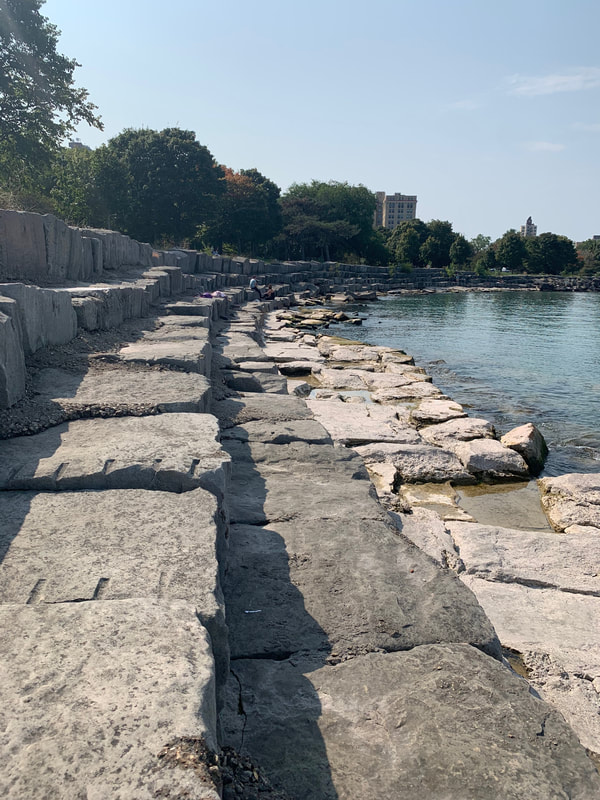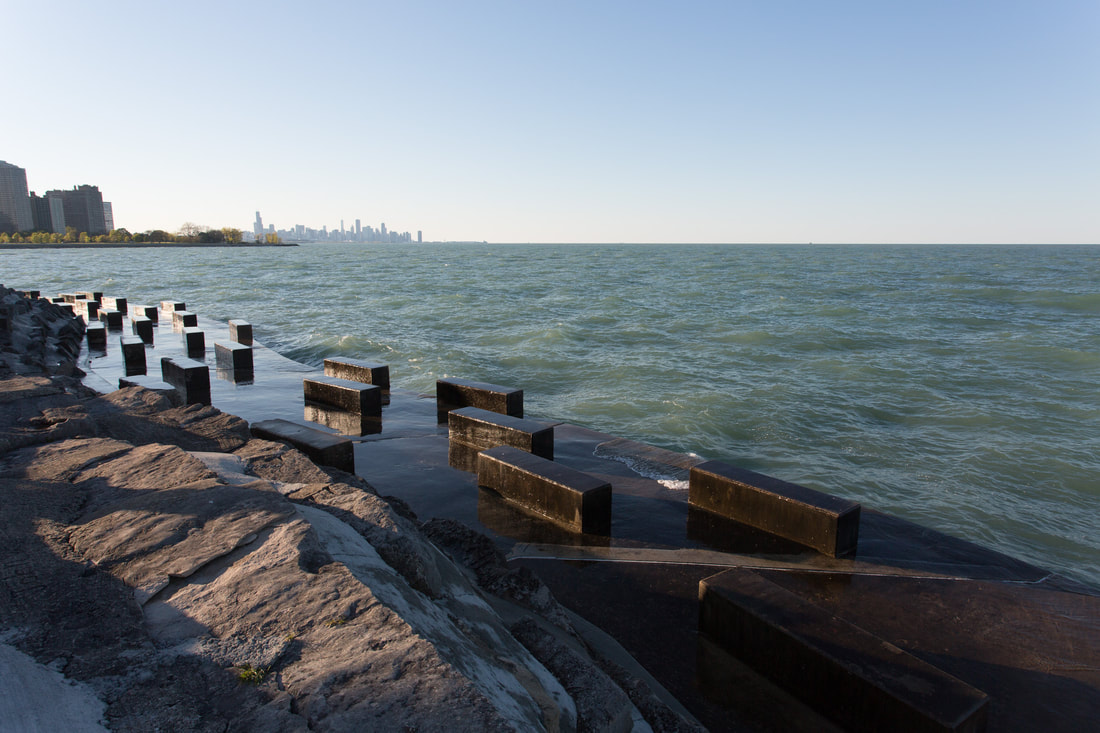|
As a three-sided peninsula, the Point calls for three different types of preservation on its south, north and east sides. The Secretary of the Interior (SOI) Standards for Historic Preservation classify repair, restoration and rehabilitation as legitimate methods of preservation construction. It is important to know that the limestone, step-stone revetment still functions after 85 years and little maintenace. This tells us that the original design of the Point's revetment can remain the design for fixing and maintaining it and this design makes genuine preservation completely feasible. Repair-in-place For example, the south side of the Point where the revetment is spared the hard pounding northeast wave action can be repaired-in-place. Without dismantling the revetment, new steel pilings can be added to reinforce the decaying wooden ones and the limestone blocks can be repositioned and regrouted in place without dismantling the revetment. Early photographs of the construction of the Point show how this repair-in-place can happen. In the left photo, a series of small cranes on the parkland -- or on barges in the water, move the limestone blocks into position. On the right, once in place, the blocks were grouted with concrete. The south side revetment can be repaired-in-place. Restoration On the north side of the Point, the limestone and the cove see a lot more winter wave action causing more erosion and shifting of the rocks. Here many of the stone blocks will need to be repaired and repositioned, again using small cranes on the parkland or on barges, and some will need to be restored and replaced with new blocks of the same material. Again the wooden crib can be reinforced with new steel pilings. Replacement blocks are available in Bedford County, Indiana, where all the limestone at the Point originally came from. Using these limestone blocks for a revetment/sea wall was a repurposing project in 1936-37. These blocks were cut from Indiana quarries but because of blemishes or fissures they could not be used for the exterior stone of many of the older buildings in downtown Chicago, on the University of Chicago campus and at the Pentagon. Mountains of these rejected stone blocks line the roadways in Bedford County near the quarries. They are available by the hundreds for replacement blocks at the Point. The north stretch of the Point can be repaired-in-place or can be fixed with restoration methods replacing damaged limestone blocks with identical existing materials . Rehabilitation: a more expensive option than repair The SOI Standards allow for changes that are in the spirit of the original design but are required for modern use. For example, the Lincoln boyhood home is preserved but with electrical lights so guests may see their way around the building safely. At the east end of the Point, the historic limestone revetment is already compromised by the 1964 concrete promonade and coffins put in by the Chicago Park District because of erosion damage. (The stones from the original promonade may be seen in the water immediately off the coffins platform.) At the eastern-northeastern revetment, wave action has eroded the fill beneath the concrete-coffin promonade, in a few places all the way into the parkland. Over its 85 year history, the erosion of the fill has caused the limestone step-stones at the north east section to tip back into the parkland because of their weight. The cheapest alternative would be to repair-in-place this section most damaged by wave action. Foam concrete can be pumped in under the coffins-platform to replace the fill eroded by storm waves. The step-stone blocks, which right now are tipped back into the parkland, could be left as is without harm or could be repaired-in-place. Another row of limestone blocks at the parkland level and some protective fabrics would secure the adjoining parkland at minimal cost and provide improved storm protection. Since this section is already historically compromised by the 1964 coffins and has the most erosion damage, it allows for all sorts of creative rehabilitation (per SOI Standards) possibilities that maximize the limestone while incorporating concrete for pathways down to the promenade and the water. This might be the best location for innovative ADA compliance with ramps and ropes, and toe stones that permit wheel-chair bound swimmers access into the water. It also gives them proximity from the promonade to the nearby restrooms in the field house. Since the Chicago Park District, the City and the Chicago US Army Corps want a "world-class solution" appropriate a world-class city, SOI rehabilitation and its additional expense might be justified and open up innovative and creative ways to maximize the historic limestone, minimize concrete using sustainable methods, and enhance access to the water for all. Here you can see the 1964 concrete promendade with the coffins and the step-stone revetment tipped back into the parkland. The east end of the Point suffers the brunt of severe storms and can be repaired-in-place. Or it might be rehabilitated to maximize the historic limestone and minimize the concrete per Secretary of the Interior Standards at additonal expense.  A wonderful example of rehabilitation is Lincoln Park's Alfred Caldwell Lily Pool which was repaired, restored and rehabilitated per SOI Standards to accomodate visitors in wheelchairs. The Lily Pool, another Caldwell design, is a National Historic Landmark and a Chicago landmark and, like the Point, draws visitors from across the City and the world.
12 Comments
3/4/2023 11:36:13 pm
I love that you mentioned the importance of maintaining and repairing your pipe system, because water damage may lead to more serious problems regarding your house. A close friend of mine told me yesterday that he had a similar problem and asked me if I know anything about his current situation. Thanks to this informative article, I'll just refer him to consult a trusted damage restoration service as soon as possible to help prevent property damage to his house.
Reply
5/10/2023 05:45:38 pm
I read your latest blog post on the repair, restoration, and rehabilitation work being done at Promontory Point with great interest. It's encouraging to see the efforts being made to preserve and enhance this historic and scenic landmark.
Reply
5/17/2023 06:48:10 pm
Dear Promontory Point,
Reply
Debra
9/6/2023 11:49:51 am
Thank you, thank you!
Reply
5/28/2023 08:01:54 pm
I recently visited your website and read your blog post on the repair, restoration, and rehabilitation efforts at Promontory Point. I wanted to express my appreciation for providing detailed information on these important endeavors.
Reply
Debra
9/6/2023 11:48:53 am
Thank you so much, Dave. Appreciate your kind words about the blog post and about our efforts to Save the Point Again!
Reply
5/31/2023 07:55:05 pm
I recently read your article titled "Point of Fact: What Repair, Restoration, and Rehabilitation at the Point Entail" on the Promontory Point website, and I wanted to express my appreciation for shedding light on the repair, restoration, and rehabilitation efforts at this historic location. Your article provides valuable insights into the scope of work involved in preserving and maintaining Promontory Point's cultural and historical significance.
Reply
Debra
9/6/2023 11:47:48 am
Thanks so much, Jacoby, for reading our blog post and for your critique. Much appreciated!
Reply
I find it interesting when you talked about the repair of parts of a certain property wherein materials will be repositioned and recruited without having to dismantle its parts. I think those kinds of jobs are done by property restoration damage specialists to keep the original design or appearance of a certain structure, via home, a park, or a building. Personally, I think those kinds of projects are great and fascinating, because the professionals will be able to revert the old appearance of a structure without changing anything at all and keeping it in great condition to make it last for a longer time for people to admire or use in the future.
Reply
Debra
9/6/2023 11:53:25 am
Thanks, Mia, for your comment to our blog post about how preservation works at Promontory Point. A preservation approach -- no demolition and no replacement with concrete -- is cheaper, stronger over a longer period, sustainable and better looking. As you may know, the Conservancy has hired its own marine engineers to determine the condition of the limestone revetment and present options for repair and rehabilitation.
Reply
9/5/2023 02:42:23 am
I find it interesting when you said that the cheapest way to repair the most damaged part of a seawall caused by the wave in action would be to repair them in place. In my opinion, it would definitely be way more affordable if you were able to invest in seawall inspection services beforehand. With their help, they can detect any problem that is just starting out to immediately fix them before they get worse.
Reply
Hi, Millie.
Reply
Leave a Reply. |
Categories
All
Archives
July 2024
AuthorDebra Hammond is currently an officer of Promontory Point Conservancy. She has always been tall for her age |




